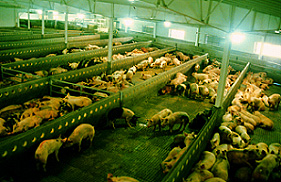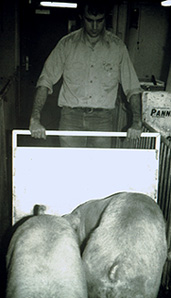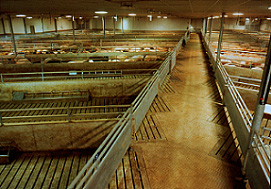

During the last five years, there have been increasing problems with highly excitable pigs which are difficult to drive at the packing plant. These animals squeal, bunch and pile up. It is difficult to make these animals separate and walk up the chute. They will constantly balk. It is caused by a combination of indiscriminate genetic selection for leaness, rapid weight gain, and a lack of stimulation in confinement buildings.

Stockyards or lairage pens for pigs in a large meat plant. This is a nicely designed facility and the animals have plenty of space in the pens to lay down and rest. Two to four hours of rest prior to slaughter will improve pork meat quality.
Packers and producers need to work together to produce pigs which will have lean, large, loin eyes, rapid weight gain and good meat quality. Highly excitable pigs have severe PSE due to agitation during handling. PSE levels will be high even though these pigs are negative on the halothane test for PSS (Porcine Stress Syndrome). Quiet, calm handling is almost impossible due to their bad temperament.

Instead of prods, a handler is moving pigs in a quiet manner with a lightweight board.
Excitability problems can also be reduced by providing confinement pigs on the farm with rubber hoses to chew on, greater contact with people in their pens and a radio. A person should walk through the finishing pens on the farm every day. The pigs need to be trained to move away from the person in an orderly, quiet manner. The person should walk through the pens in a different direction every day to train the pigs to tolerate novelty and change in routine. Playing a radio in the finishing barn gets the animals accustomed to different kinds of sounds. Bad flooring in the finishing barn can also cause problems. Pigs finished on metal or plastic floors will have excessive hoof growth. These animals will balk constantly in the plant.

This is a picture of a Herringbone stockyard or lairage for pigs that illustrates an ideal flooring situation.

 The
National Pork Producers Council. This website contains just
about everything there is to know about pigs and pork, from industry news
and education to recipes.
The
National Pork Producers Council. This website contains just
about everything there is to know about pigs and pork, from industry news
and education to recipes.


Grandin, T.(1995)
PSE Is Still A Problem
Meat and Poultry. December, page 14
Grandin, T. (1995)
Bruise Levels on Fed and Non-Fed Cattle.
Livestock Conservation Institute
79th Annual Meeting Proceedings
1910 Lyda Drive
Bowling Green, Kentucky 42104-5809
pages 193-197
Grandin, T.(1994)
Methods to reduce PSE and bloodsplash.
Allen D. Leman Swine Conference
Volume 21 pages 206-209
College of Veterinary Medicine,
University of Minnesota.
Grandin, T.(1994)
Troubleshooting Handling Problems
Meat and Poultry December, page 62
Grandin, T.(1993)
Environmental and Genetic Factors Which Contribute
To Handling Problems At Pork Slaughter Plants
in:E.Collins and C.Boon (Editors) Livestock Environment
IV American Society of Agriculture Engineers
2950 Niles Road. St.Joseph, Michigan 49085
USA